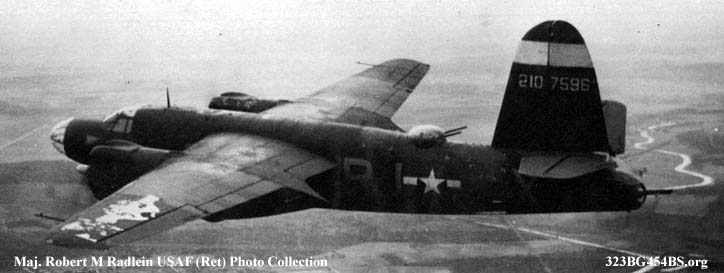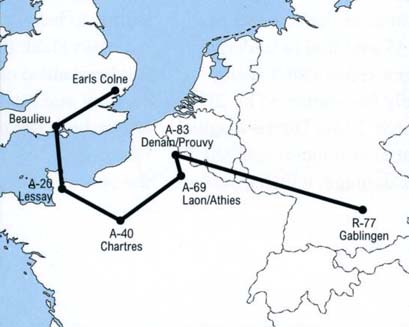Insignia: Shield: Per bend between a mailed Dexter gauntlet grasping a dagger and the winged hat of Mercury argent. Motto: VINCAMUS SINE TIMORIS--Without Fear We Conquer. Nickname: The White Tails. Called the “White Tails” because of white ID bar on aircraft tails. History: Constituted as 323rd Bombardment Group (Medium) on June 19, 1942. Activated on August 4, 1942 at Columbia AAB, SC. The first phase of training commenced at MacDill Field, Florida on the 21st of August 1942. Trained with B-26 Medium Bombers. The unit moved to Myrtle Beach Field, SC on the first to the third of November 1942. In mid February 1943, picked up new B-26Cs at Bear Field in Indiana. The 453rd, 454th and 455th moved to Hunter Field, Ga. in preparation for overseas movement to the United Kingdom via the southern ferry route. The 456 BS left in early May of 1943 by the northern ferry route. In June 1943 the ground unit left Myrtle Beach on the 25th of April 1943 and sailed on the Queen Elizabeth on the 5th of May 1943, and arrived in Gourock, England on the 11th of May 1943. First assigned to the Eighth Air Force. Began operations in July 1943, attacking marshaling yards, airdromes, industrial plants, military installations, and other targets in France, Belgium, and Holland. Assigned to the 9th Air Force, IX BC on October 16, 1943. Moved to Beaulieu in July 1944 and to France in Late August 1944. Carried out numerous attacks on V- weapon sites along the coast of France. Attacked airfields at Leeuwarden and Venlo in conjunction with the Allied campaign against the German Air Force and aircraft industry during Big Week, Feb. 20-25, 1944. Helped to prepare for the invasion of Normandy by bombing coastal batteries on June 6, 1944. Participated in the aerial barrage that assisted the breakthrough at St. Lo in July 1944. Flew tactical missions in support of Allied ground forces. Flew its first night mission after moving to the Continent in Aug., striking enemy batteries in the region of St. Malo. Carried out other night missions during the month to hit fuel and ammunition dumps. Eliminated strong points at Brest early in September and then shifted operations to eastern France to support advances against the Siegfried Line. Received a DUC for actions (Dec. 24-27, 1944) during the Battle of the Bulge when the group effectively hit transportation installations used by the enemy to bring reinforcements to the Ardennes. Flew interdictory missions into the Ruhr and supported the drive into Germany by attacking enemy communications. Ended combat in April 1945. Moved to Germany in May to participate in the disarmament program. The unit returned to the US in December 1945. Inactivated on 12 Dec. 1945.
|
|||||||||||||||||||||||||||||||||||||||||||||||||||||||||||
|
|||||||||||||||||||||||||||||||||||||||||||||||||||||||||||
 |
|||||||||||||||||||||||||||||||||||||||||||||||||||||||||||
42-107596
RJ-X Paper Dolly II a B-26C-45-MO leading a raid into Germany. |
|||||||||||||||||||||||||||||||||||||||||||||||||||||||||||
|
323rd Bomb Group Statistics
Dropped 15,067 Tons of Bombs 1st Mission: July 16th, 1943 - The
Abbeville Marshaling Yards, France. |
|||||||||||||||||||||||||||||||||||||||||||||||||||||||||||






